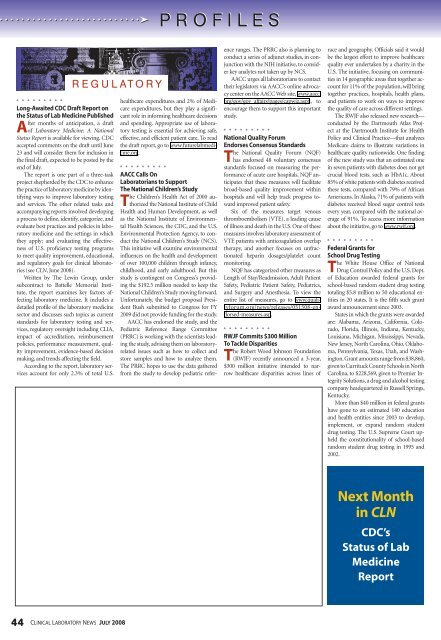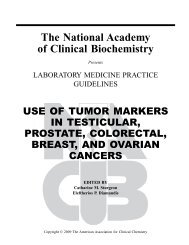Clinical Laboratory News - American Association for Clinical ...
Clinical Laboratory News - American Association for Clinical ...
Clinical Laboratory News - American Association for Clinical ...
You also want an ePaper? Increase the reach of your titles
YUMPU automatically turns print PDFs into web optimized ePapers that Google loves.
long-awaited cdc draft report on<br />
the status of lab medicine published<br />
after months of anticipation, a draft<br />
of <strong>Laboratory</strong> Medicine: A National<br />
Status Report is available <strong>for</strong> viewing. CDC<br />
accepted comments on the draft until June<br />
23 and will consider them <strong>for</strong> inclusion in<br />
the final draft, expected to be posted by the<br />
end of July.<br />
The report is one part of a three-task<br />
project shepherded by the CDC to enhance<br />
the practice of laboratory medicine by identifying<br />
ways to improve laboratory testing<br />
and services. The other related tasks and<br />
accompanying reports involved developing<br />
a process to define, identify, categorize, and<br />
evaluate best practices and policies in laboratory<br />
medicine and the settings in which<br />
they apply; and evaluating the effectiveness<br />
of U.S. proficiency testing programs<br />
to meet quality improvement, educational,<br />
and regulatory goals <strong>for</strong> clinical laboratories<br />
(see CLN, June 2008).<br />
Written by The Lewin Group, under<br />
subcontract to Battelle Memorial Institute,<br />
the report examines key factors affecting<br />
laboratory medicine. It includes a<br />
detailed profile of the laboratory medicine<br />
sector and discusses such topics as current<br />
standards <strong>for</strong> laboratory testing and services,<br />
regulatory oversight including CLIA,<br />
impact of accreditation, reimbursement<br />
policies, per<strong>for</strong>mance measurement, quality<br />
improvement, evidence-based decision<br />
making, and trends affecting the field.<br />
According to the report, laboratory services<br />
account <strong>for</strong> only 2.3% of total U.S.<br />
reguLatory<br />
44 CliniCal laboratory news JuLy 2008<br />
p r o f i L e s<br />
p r o f i L e s<br />
healthcare expenditures and 2% of Medicare<br />
expenditures, but they play a significant<br />
role in in<strong>for</strong>ming healthcare decisions<br />
and spending. Appropriate use of laboratory<br />
testing is essential <strong>for</strong> achieving safe,<br />
effective, and efficient patient care. To read<br />
the draft report, go to www.futurelabmedicine.org.<br />
aacc calls on<br />
laboratorians to support<br />
The national children’s study<br />
Children’s Health Act of 2000 au-<br />
T he<br />
thorized the National Institute of Child<br />
Health and Human Development, as well<br />
as the National Institute of Environmental<br />
Health Sciences, the CDC, and the U.S.<br />
Environmental Protection Agency, to conduct<br />
the National Children’s Study (NCS).<br />
This initiative will examine environmental<br />
influences on the health and development<br />
of over 100,000 children through infancy,<br />
childhood, and early adulthood. But this<br />
study is contingent on Congress’s providing<br />
the $192.5 million needed to keep the<br />
National Children’s Study moving <strong>for</strong>ward.<br />
Un<strong>for</strong>tunately, the budget proposal President<br />
Bush submitted to Congress <strong>for</strong> FY<br />
2009 did not provide funding <strong>for</strong> the study.<br />
AACC has endorsed the study, and the<br />
Pediatric Reference Range Committee<br />
(PRRC) is working with the scientists leading<br />
the study, advising them on laboratoryrelated<br />
issues such as how to collect and<br />
store samples and how to analyze them.<br />
The PRRC hopes to use the data gathered<br />
from the study to develop pediatric refer-<br />
ence ranges. The PRRC also is planning to<br />
conduct a series of adjunct studies, in conjunction<br />
with the NIH initiative, to consider<br />
key analytes not taken up by NCS.<br />
AACC urges all laboratorians to contact<br />
their legislators via AACC’s online advocacy<br />
center on the AACC Web site, www.aacc.<br />
org/gov/gov_affairs/pages/capwiz.aspx, to<br />
encourage them to support this important<br />
study.<br />
national Quality <strong>for</strong>um<br />
endorses consensus standards<br />
The National Quality Forum (NQF)<br />
has endorsed 48 voluntary consensus<br />
standards focused on measuring the per<strong>for</strong>mance<br />
of acute care hospitals. NQF anticipates<br />
that these measures will facilitate<br />
broad-based quality improvement within<br />
hospitals and will help track progress toward<br />
improved patient safety.<br />
Six of the measures target venous<br />
thromboembolism (VTE), a leading cause<br />
of illness and death in the U.S. One of these<br />
measures involves laboratory assessment of<br />
VTE patients with anticoagulation overlap<br />
therapy, and another focuses on unfractionated<br />
heparin dosages/platelet count<br />
monitoring.<br />
NQF has categorized other measures as<br />
Length of Stay/Readmission, Adult Patient<br />
Safety, Pediatric Patient Safety, Pediatrics,<br />
and Surgery and Anesthesia. To view the<br />
entire list of measures, go to www.quality<strong>for</strong>um.org/news/releases/051508-endorsed-measures.asp.<br />
rWjf commits $300 million<br />
To Tackle disparities<br />
The Robert Wood Johnson Foundation<br />
(RWJF) recently announced a 3-year,<br />
$300 million initiative intended to narrow<br />
healthcare disparities across lines of<br />
race and geography. Officials said it would<br />
be the largest ef<strong>for</strong>t to improve healthcare<br />
quality ever undertaken by a charity in the<br />
U.S. The initiative, focusing on communities<br />
in 14 geographic areas that together account<br />
<strong>for</strong> 11% of the population, will bring<br />
together practices, hospitals, health plans,<br />
and patients to work on ways to improve<br />
the quality of care across different settings.<br />
The RWJF also released new research—<br />
conducted by the Dartmouth Atlas Project<br />
at the Dartmouth Institute <strong>for</strong> Health<br />
Policy and <strong>Clinical</strong> Practice—that analyzes<br />
Medicare claims to illustrate variations in<br />
healthcare quality nationwide. One finding<br />
of the new study was that an estimated one<br />
in seven patients with diabetes does not get<br />
crucial blood tests, such as HbA1c. About<br />
85% of white patients with diabetes received<br />
these tests, compared with 79% of African<br />
<strong>American</strong>s. In Alaska, 71% of patients with<br />
diabetes received blood sugar control tests<br />
every year, compared with the national average<br />
of 91%. To access more in<strong>for</strong>mation<br />
about the initiative, go to www.rwjf.org.<br />
federal Grants <strong>for</strong><br />
school drug Testing<br />
The White House Office of National<br />
Drug Control Policy and the U.S. Dept.<br />
of Education awarded federal grants <strong>for</strong><br />
school-based random student drug testing<br />
totaling $5.8 million to 50 educational entities<br />
in 20 states. It is the fifth such grant<br />
award announcement since 2003.<br />
States in which the grants were awarded<br />
are: Alabama, Arizona, Cali<strong>for</strong>nia, Colorado,<br />
Florida, Illinois, Indiana, Kentucky,<br />
Louisiana, Michigan, Mississippi, Nevada,<br />
New Jersey, North Carolina, Ohio, Oklahoma,<br />
Pennsylvania, Texas, Utah, and Washington.<br />
Grant amounts range from $38,860,<br />
given to Currituck County Schools in North<br />
Carolina, to $228,569, given to Premier Integrity<br />
Solutions, a drug and alcohol testing<br />
company headquartered in Russell Springs,<br />
Kentucky.<br />
More than $40 million in federal grants<br />
have gone to an estimated 140 education<br />
and health entities since 2003 to develop,<br />
implement, or expand random student<br />
drug testing. The U.S. Supreme Court upheld<br />
the constitutionality of school-based<br />
random student drug testing in 1995 and<br />
2002.<br />
next month<br />
in CLN<br />
cdc’s<br />
status of lab<br />
medicine<br />
report
















